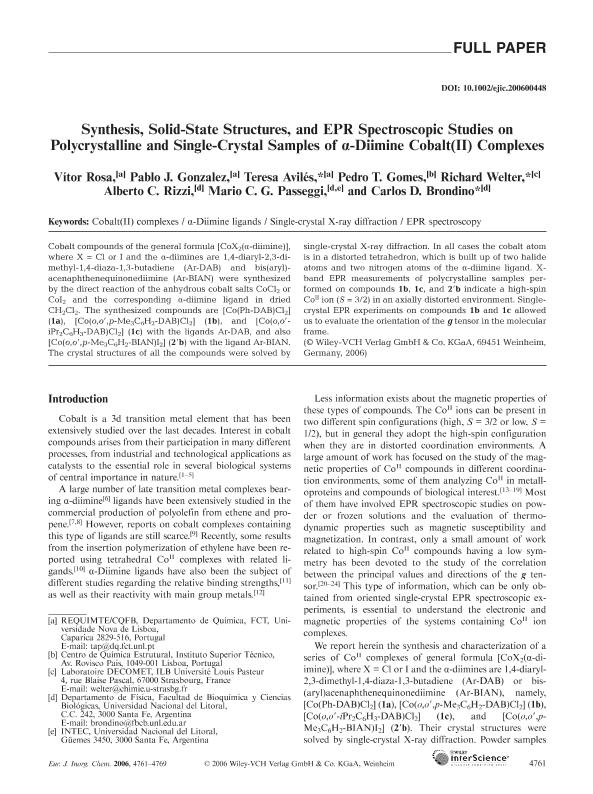Mostrar el registro sencillo del ítem
dc.contributor.author
Rosa, Vítor
dc.contributor.author
González, Pablo Javier

dc.contributor.author
Avilés, Teresa
dc.contributor.author
Gomes, Pedro
dc.contributor.author
Welter, Richard
dc.contributor.author
Rizzi, Alberto Claudio

dc.contributor.author
Passeggi, Mario Cesar Genaro

dc.contributor.author
Brondino, Carlos Dante

dc.date.available
2017-10-12T21:20:53Z
dc.date.issued
2006-10
dc.identifier.citation
Rosa, Vítor; González, Pablo Javier; Avilés, Teresa; Gomes, Pedro; Welter, Richard; et al.; Synthesis, Solid-State Structures, and EPR Spectroscopic Studies on Polycrystalline and Single-Crystal Samples of α-Diimine Cobalt(II) Complexes; Wiley VCH Verlag; European Journal of Inorganic Chemistry; 2006; 23; 10-2006; 4761-4769
dc.identifier.issn
1434-1948
dc.identifier.uri
http://hdl.handle.net/11336/26537
dc.description.abstract
Cobalt compounds of the general formula [CoX2(a-diimine)], where X = Cl or I and the a-diimines are 1,4-diaryl-2,3-dimethyl- 1,4-diaza-1,3-butadiene (Ar-DAB) and bis(aryl)- acenaphthenequinonediimine (Ar-BIAN) were synthesized by the direct reaction of the anhydrous cobalt salts CoCl2 or CoI2 and the corresponding a-diimine ligand in dried CH2Cl2. The synthesized compounds are [Co(Ph-DAB)Cl2] (1a), [Co(o,o',p-Me3C6H2-DAB)Cl2] (1b), and [Co(o,o'- iPr2C6H3-DAB)Cl2] (1c) with the ligands Ar-DAB, and also [Co(o,o',p-Me3C6H2-BIAN)I2] (2'b) with the ligand Ar-BIAN. The crystal structures of all the compounds were solved by Introduction Cobalt is a 3d transition metal element that has been extensively studied over the last decades. Interest in cobalt compounds arises from their participation in many different processes, from industrial and technological applications as catalysts to the essential role in several biological systems of central importance in nature.[1–5] A large number of late transition metal complexes bearing a-diimine[6] ligands have been extensively studied in the commercial production of polyolefin from ethene and propene.[ 7,8] However, reports on cobalt complexes containing this type of ligands are still scarce.[9] Recently, some results from the insertion polymerization of ethylene have been reported using tetrahedral CoII complexes with related ligands.[ 10] a-Diimine ligands have also been the subject of different studies regarding the relative binding strengths,[11] as well as their reactivity with main group metals.[12] [a] REQUIMTE/CQFB, Departamento de Química, FCT, Universidade Nova de Lisboa, Caparica 2829-516, Portugal E-mail: tap@dq.fct.unl.pt [b] Centro de Química Estrutural, Instituto Superior Técnico, Av. Rovisco Pais, 1049-001 Lisboa, Portugal [c] Laboratoire DECOMET, ILB Université Louis Pasteur 4, rue Blaise Pascal, 67000 Strasbourg, France E-mail: welter@chimie.u-strasbg.fr [d] Departamento de Física, Facultad de Bioquímica y Ciencias Biológicas, Universidad Nacional del Litoral, C.C. 242, 3000 Santa Fe, Argentina E-mail: brondino@fbcb.unl.edu.ar [e] INTEC, Universidad Nacional del Litoral, Güemes 3450, 3000 Santa Fe, Argentina Eur. J. Inorg. Chem. 2006, 4761–4769 © 2006 Wiley-VCH Verlag GmbH & Co. KGaA, Weinheim 4761 single-crystal X-ray diffraction. In all cases the cobalt atom is in a distorted tetrahedron, which is built up of two halide atoms and two nitrogen atoms of the a-diimine ligand. Xband EPR measurements of polycrystalline samples performed on compounds 1b, 1c, and 2'b indicate a high-spin CoII ion (S = 3/2) in an axially distorted environment. Singlecrystal EPR experiments on compounds 1b and 1c allowed us to evaluate the orientation of the g tensor in the molecular frame.
dc.format
application/pdf
dc.language.iso
eng
dc.publisher
Wiley VCH Verlag

dc.rights
info:eu-repo/semantics/openAccess
dc.rights.uri
https://creativecommons.org/licenses/by-nc-sa/2.5/ar/
dc.subject
Epr
dc.subject
Co(Ii)
dc.subject
Complexes
dc.subject.classification
Otras Ciencias Químicas

dc.subject.classification
Ciencias Químicas

dc.subject.classification
CIENCIAS NATURALES Y EXACTAS

dc.title
Synthesis, Solid-State Structures, and EPR Spectroscopic Studies on Polycrystalline and Single-Crystal Samples of α-Diimine Cobalt(II) Complexes
dc.type
info:eu-repo/semantics/article
dc.type
info:ar-repo/semantics/artículo
dc.type
info:eu-repo/semantics/publishedVersion
dc.date.updated
2017-10-10T18:32:31Z
dc.journal.volume
2006
dc.journal.number
23
dc.journal.pagination
4761-4769
dc.journal.pais
Alemania

dc.description.fil
Fil: Rosa, Vítor. Universidad Nova de Lisboa;
dc.description.fil
Fil: González, Pablo Javier. Universidad Nacional del Litoral; Argentina
dc.description.fil
Fil: Avilés, Teresa. Universidad Nova de Lisboa;
dc.description.fil
Fil: Gomes, Pedro. Instituto Superior Tecnico; Portugal
dc.description.fil
Fil: Welter, Richard. Universite Louis Pasteur; Francia
dc.description.fil
Fil: Rizzi, Alberto Claudio. Universidad Nacional del Litoral. Facultad de Bioquímica y Ciencias Biológicas. Departamento de Física; Argentina
dc.description.fil
Fil: Passeggi, Mario Cesar Genaro. Consejo Nacional de Investigaciones Científicas y Técnicas. Centro Científico Tecnológico Conicet - Santa Fe. Instituto de Desarrollo Tecnológico para la Industria Química. Universidad Nacional del Litoral. Instituto de Desarrollo Tecnológico para la Industria Química; Argentina
dc.description.fil
Fil: Brondino, Carlos Dante. Universidad Nacional del Litoral. Facultad de Bioquímica y Ciencias Biológicas. Departamento de Física; Argentina. Consejo Nacional de Investigaciones Científicas y Técnicas; Argentina
dc.journal.title
European Journal of Inorganic Chemistry

dc.relation.alternativeid
info:eu-repo/semantics/altIdentifier/url/http://www3.interscience.wiley.com/journal/113388781/abstract
dc.relation.alternativeid
info:eu-repo/semantics/altIdentifier/doi/http://dx.doi.org/10.1002/ejic.200600448
Archivos asociados
